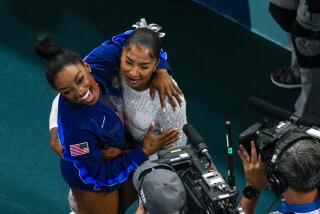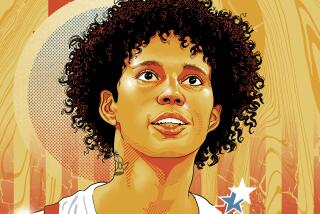Gliding Past Adversity
- Share via
Arms spread like wings, 11-year-old Grisha Fournier zips across the ice, 70 pounds of intensity on skates. A gaggle of little girls in sparkly skating costumes, sort of Grisha groupies, cheers him on.
Two-and-a-half years ago, Grisha was in a Russian orphanage. Today, he is a schoolkid in Rancho Cucamonga talking about “when I get to the Olympics” in 2010. His heart is set on following in the skateprints of reigning men’s Olympic gold medalist Alexi Yagudin of Russia--but doing it as an American.
Is he competitive? “Yeah,” but “you don’t want to get too cocky so your head blows up,” says Grisha, a charismatic, auburn-haired fifth-grader who’s been figure skating for only a year but has won three of the four competitions he’s entered.
On a recent Saturday at Center Ice in Ontario, his parents, Gina, 40, and Mike, 45, watched as Grisha took to the ice in the Rim of the World Open Championships, catching their breath as he missed an axel jump and fell. But, as quickly as he went down, Grisha was up again, executing a flawless axel.
Off the ice, getting an encouraging hug from his mother, he was annoyed with himself--”That jump is one I do every day.” His father observed, “A lot of kids would fall apart” after missing a jump. “He doesn’t.”
The kid has grit and determination, qualities associated with a survivor. Which he is. Abandoned by his mother when he was 2, Grisha lived with his alcoholic father and later with his older sister, Kseniya (called Susha), in their elderly grandmother’s one-room apartment in Perm, a Ural regions city of 1 million. When the grandmother could no longer care for them, she placed them in an orphanage known as Children’s Home No. 7.
There they stayed for about two years, two of hundreds of older children for whom adoption--especially as members of a sibling group--is a faint hope.
For Susha and Grisha, there had been one wrenching disappointment. In the summer of 1999, they’d been among abandoned and institutionalized children brought to America by Kidsave International for an eight-week stay--the first time they’d left Perm. But their host family in Memphis, Tenn., decided not to adopt them. “They wanted me,” says 14-year-old Susha, but not Grisha. The two refused to be separated.
So, it was back to the orphanage. But that August, as Gina Fournier was browsing the Internet, she read about the siblings on an adoption Web site. She and Mike had been hoping for two years to adopt an infant.
“We’d already ruled out international adoption because of the cost,” Gina says. Still, she was intrigued enough to contact Kidsave, which promptly sent a grainy video of Susha and Grisha being interviewed at the orphanage--a rather solemn girl of 11 and a gap-toothed boy of 8.
“We didn’t know what we could handle,” Gina adds. “We’d read all the horror stories about Romanian adoptions,” of children with severe trauma and stress disorders. But, watching the video, they “fell in love immediately.”
In February 2000, the Fourniers traveled to Perm to meet the kids they’d decided to adopt. “It was a leap of faith,” Gina says. “But it’s just been magic from Day 1. We’re much luckier than they are. They would have been something no matter what. But our house was so empty before them.” Although they learned right afterward that a birth mother had chosen them to adopt her infant, they have no regrets, Gina says. “Fifty million people were lined up for that infant. No one wanted these kids.”
That first meeting in Perm, all parties agree, was “kind of scary.” Susha was “frozen in fear,” Gina says. “Now she’s Miss Outgoing.” The Fourniers had sent the children pictures of their home. Grisha says, “It was scary for the first 30 seconds, but then it was, like, yes! I’m, like--whoa!--a giant bedroom.” Seeing the backyard spa, Grisha says, “We thought it was a giant bathtub.”
A week after the Fourniers returned to their Alta Loma home, Susha and Grisha flew to L.A. They spoke almost no English. Grisha recalls, “Me and my sister would talk at the dinner table in Russian. My parents said, ‘No more Russian at the table.’ That’s how we learned English.” The Fourniers anglicized his given name--Grigori--to Gregory, but he chooses to keep his nickname, Grisha. Mike laughs and says, “On the [Little League] baseball team, he’s Greg. On the ice, he’s Grisha. Analyze that.”
Soon after Grisha and Susha arrived, they learned that their father had died in an alcohol-related accident. They maintain some ties to Russia, telephoning their grandmother once a month. Grisha, who now speaks English better than Russian, can be overheard saying, “yeah, yeah--I mean, da.”
To help them make the transition to Southern California, Gina signed them up for an eight-week city recreation figure-skating program. Then, she says, “we moved on to soccer. Grisha didn’t like it. It was too hot.” He took to baseball, but at 4 feet, 6 inches he was a bit short. He tried gymnastics but promptly fell on his head. Going back to Plan A, Gina says, “we thought ice hockey. I got on EBay and got him a $10 pair of figure skates and a pair of hockey skates and put him on the ice. The first time he tried the figure skates, he said, ‘Oh, I like these better.’ ”
She had certain reservations. First, it is expensive. And “Grisha is a guy. You know the stereotypes about male skaters--’Men in Tights.’ ” She worried that he’d be teased at school. But, she says, he’s pretty popular at Caryn Elementary in Rancho Cucamonga and just tells schoolmates that a skater must be strong and athletic.
Soon, Grisha was spotted by veteran coach Joan Heasley, whose daughter Vicki was a world-class pairs skater in the late ‘70s. Joan Heasley and partner Brian Tuck, who in 1956 represented Great Britain in the Olympics, asked last December to coach him.
Heasley says it’s been 20 years since she coached a skater with such potential. “He’s exceptionally gifted. He doesn’t sulk or complain.” Since Heasley and Tuck have been coaching him, she says, he’s progressed “more than the average child in three years. This kid has not only talent but drive, determination and good attitude. He crashes and never minds falling. The most dedicated skater we’ve ever worked with.”
Grisha’s enjoying it while it lasts. “I mostly like performing,” Grisha says, fixing listeners with his big brown eyes.
“I kind of like to know that somebody’s watching.” He smiles, revealing a mouthful of braces, and says, “I fall down a lot. If you don’t fall down a lot, it means you’re not trying hard enough. It’s no good if you just do tiny jumps” and stay on your feet.
He has no interest in pairs skating. “When you get a medal, you want to know that you did it all by yourself. Nobody was out there to help you.”
Asked which is his most difficult jump, Grisha asks, “That I can land?” That would be the axel, the one he flubbed in the recent competition, even though he went on to best three other young skaters and take first place.
“He really poured it on with his footwork” to erase judges’ memories of the tumble, Gina says. Grisha is into fancy footwork, for which Russian skaters are noted, and he sometimes explains, “Mom, I’m Russian.”
He knows that he “kind of started skating a little behind time” for an Olympic hopeful and has some catching up to do. Commonly, skaters begin at 7 or 8, some even earlier.
Heasley says their goal, which she acknowledges is very ambitious, is for Grisha to compete in the juvenile division by the end of next year. That’s three levels up from pre-preliminary, his current division. If he does that and is one of the top four juvenile boys in the Southwest, he’ll get to go to the U.S. figure-skating championships. “If ever anybody could do it, it’s Grisha,” Heasley says.
But it is a long and expensive road to the Olympics. And there are limits to what Gina, who works part time from home writing proposals for a government agency career center, and Mike, a cost accountant with Cytec, an Anaheim-based aerospace materials manufacturer, can afford.
Heasley and Tuck are giving them a break on coaching, for which fees can run $80 to $100 an hour and average $1,500 a month. In addition, ice time is $8 an hour, and Grisha practices 90 minutes at least six days a week. Acting lessons, ballet lessons, a choreographer and a costumer will be part of the mix. And he just got his first pair of new skates: $500.
“It’s like anything you go into,” Gina says. “You start out thinking, ‘Oh, this is fun,’ and you end up getting sucked in by the sport and your kid’s success and the joy he has in doing it. It started so small, a lesson here, a lesson there, and it just took off. It gave him so much self-esteem.”
Susha, a pretty blond with deep dimples, expressed little interest in skating but is usually there to cheer for Grisha. “She’s very protective of her brother, very supportive,” Gina says. “She sees he’s got talent. There’s no jealousy. Her talent is different, not so flashy.” A freshman at Rancho Cucamonga High School, she is a top student and, her mother says, her goal is to get a fully paid scholarship to a four-year college.
Although focused on skating, Grisha still likes baseball. He also likes to “collect stuff like remote control cars.” And, he grins, trophies.
More to Read
Go beyond the scoreboard
Get the latest on L.A.'s teams in the daily Sports Report newsletter.
You may occasionally receive promotional content from the Los Angeles Times.






